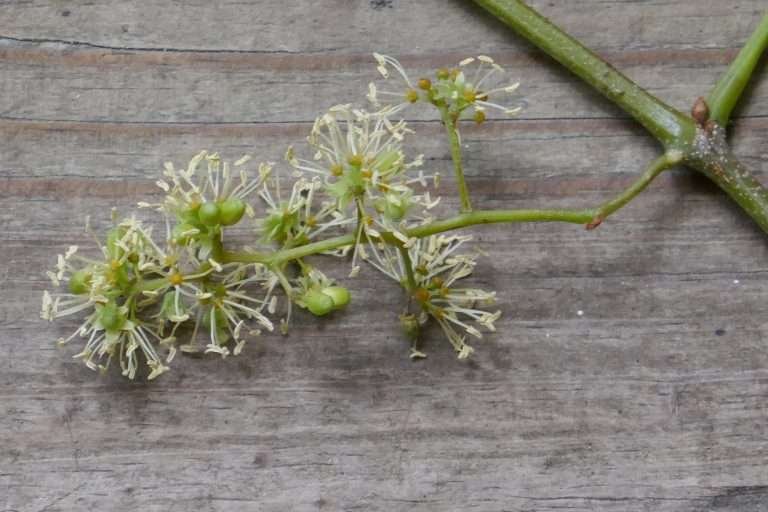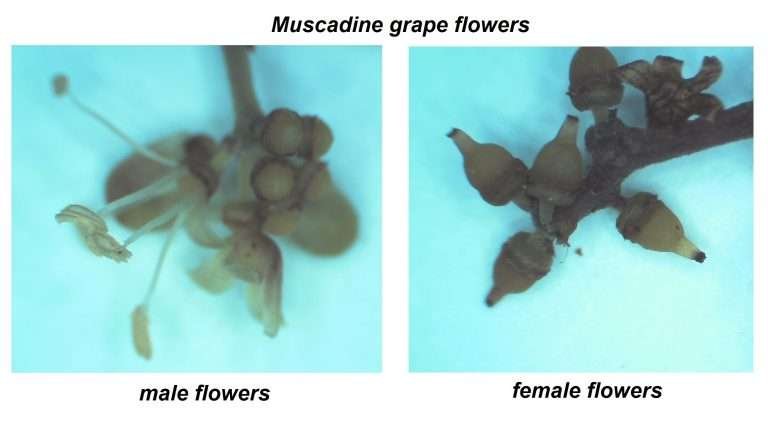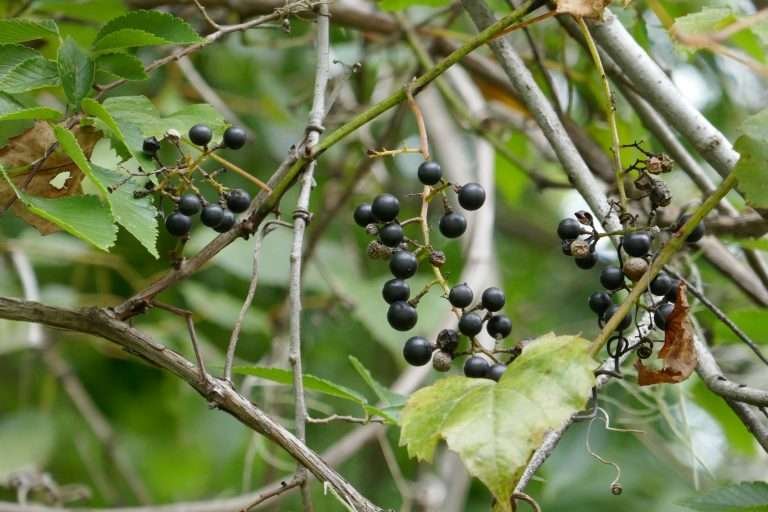
Vitis rotundifolia
(Muscadine Grapevine)
Oddly enough many people bemoan having a native grapevine in their green space, but honestly it is a fantastic wildlife plant. It has the potential to be aggressive, but it can be pruned and trained to your liking. If it attempts to get out of hand, simply prune it back to the main stem. Actually, grapes need to be pruned in order to produce fruit, and this happens only on new growth, so pruning each year helps to ensure a crop of grapes. A female grape vine is a wonderful plant to have. It is a very useful plant for both humans and wildlife.

Common Names, Latin Name, and Family
Muscadine grape, bullace, Southern fox grape, summer grape, and scuppernong.
Its Latin name is Vitis rotundifolia.
Viti means pertaining to the vine. Rotund means round and folia means leaf.
It is found in the Vitaceae, or grape family. Other plants in this family include Virginia creeper, pepper vine, and marine vine.
Form
A muscadine grape vine is a perennial, woody, vine that has the potential to grow to 100 feet in length. It attaches itself to surrounding vegetation by tendrils. The tendrils on the muscadine grape are unbranched, which makes it a key feature for identification.
The vine climbs into surrounding trees and vegetation in search of sunlight and support. It can take over a small area rather quickly so it is best to keep it pruned to your available space and liking. Training a grapevine on a trellis can be a relaxing and rewarding hobby.
Leaving a grapevine to its own devices is equally rewarding as a wonderful, non-maintenance, native plant addition to a wildlife habitat.

Leaves
The leaves are alternate, simple, and stalked. Leaf shape is generally heart shaped with toothed margins. The upper surface is smooth and hairless, but the underside may have hairs or not. The tendrils are unbranched.

Flowers
The flowers appear in late spring and early summer.
The flowers are small and inconspicuous for the most part.
Grape vines are dioecious which means that male and female flowers grow on separate vines.
Only the female vine produces grapes.


Fruit
A small round berry / grape purple to almost black in color.
Wild grapes are about the size of peas and have thick skin, and large seeds, but a wonderful flavor.

Habitat
Muscadine grape is a very common component of Florida’s natural forests and hammocks.
It is found in wet forests, dry forests and scrub. It is also notoriously found along fence rows, and the bases of trees, where birds drop the seeds in their excrement.

Native Range
It occurs naturally in every county of Florida.
Muscadine grape is native to the following states: Alabama, Arkansas, Delaware, Florida, Georgia, Kentucky, Louisiana, Maryland, Missouri, Mississippi, North Carolina, Oklahoma, South Carolina, Tennessee, Texas, Virginia, and West Virginia.
Landscape Use
It is an aggressive vine unless you have the space to let it ramble into the tree canopy. However, it can be kept pruned and trained to grow along fences or trellises where collecting fruit is an easier task and the vine doesn’t become a problem.
Grapevines grow in part shade with average moisture, but can tolerate drought once established. They must have well drained soil and will drown if the soil is constantly waterlogged.
Keep pruned annually for the best fruit production. Once a cane produces grapes it will not produce fruit again on that cane. New growth is what is needed for flower production so pruning the older canes once the grapes are gone produces the best crop.
Please do not be angry at the wildlife when they find your grapes, and eat them, because they rely on them as a natural food. I mention this because my neighbors shoot opossums for eating fruit growing in their yard and I honestly believe it’s wrong to kill an animal for no better reason than it eating food to survive … especially its native food.

Wildlife Uses
Florida wildlife love Florida grapes. Ripe grapes are a favorite of songbirds, gamebirds, wood ducks, bear, coyote, opossum, rabbit, raccoon, skunk, and squirrels.
The tender new foliage is eaten by white-tailed deer and other mammals.
Grapes that have been left to dry on the vine are an important food source for wildlife during the lean times of winter.
The dense vegetation that a grape vine provides gives shelter and nesting sites to many songbirds. Some animals also use thin strips of the mature bark for nesting material.
Grapevines are a host plant for the Nessus sphinx moth (Amphion floridensis) and the Mournful sphinx moth (Enyo lugubris).

Human Uses
American Indians used leaf tea for diarrhea, hepatitis, stomachaches, thrush, externally, poultice wilted leaves for sore breasts, also poulticed leaves for rheumatism, headaches, fevers.
The Greek culture makes a dish called dolmades which is a mixture of rice and meat wrapped into small packets using grape leaves. They may be stored in a brine or used immediately with a savory sauce.
Vines, when cut in summer, yield potable water if you’re in a survival situation and need drinking water.
The vines are very versatile and can be used for weaving baskets, wreaths, and tethering items together. Best used when green because they are more pliable when fresh.
The wood can be used for climbing structures in reptile enclosures, for small pet chew sticks like hamsters or rats, and if it’s large enough it can be used for woodworking crafts. Its uses are only limited by your imagination because it is a very versatile wood.
The fruit makes wonderful jellies and jams. Granted the fruit isn’t the easiest to harvest because the vines tend to climb high up into the tree canopy. However, if you have one that can be kept pruned, and trellised, collecting grapes will be less of a chore and produce more grapes than left on its own.
The unripe, green, grapes contain the most pectin so incorporating some of those into your jelly recipe can help it set better.
Young leaves can be used, boiled, as a potherb and as wraps for making Greek dolma.
Last but not least is the fact that wild grapes make a fantastic wine. It’s a labor of love, but so worth the effort.
Propagation
It’s tempting to grow the seedling volunteers you may find, but remember they will most likely be male plants and never produce grapes. It’s best to use known female cuttings.
Grape vine can be rooted from hardwood or softwood cuttings. Use pieces at least 8-10 inches in length with at least three buds. Dip in rooting hormone and place in moist soil. Place the growing container a plastic bag, to retain moisture and hopefully in 6 to 8 weeks they should have begun developing roots. Transplant into individual pots and allow them to form a well developed root system before transplanting into the garden.
Ashley from Practical Self Reliance has some great advice on propagating grape vines. https://practicalselfreliance.com/propagating-grape-vines/